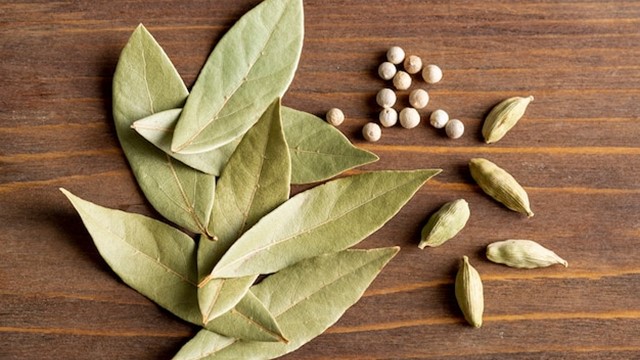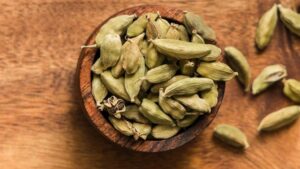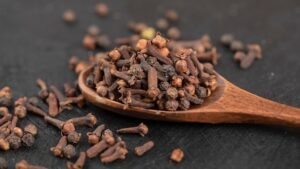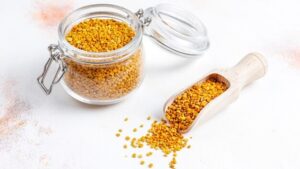Bay leaves, often referred to as bay laurel or bay leaf, are aromatic leaves derived from the bay laurel tree, scientifically known as Laurus nobilis. These leaves are widely used as a culinary herb to add flavor and aroma to various dishes.
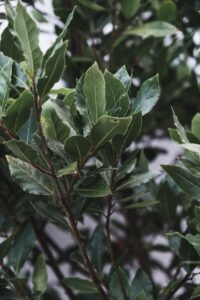
Physical Characteristics:
Bay leaves, derived from the bay laurel tree (Laurus nobilis), possess distinct physical characteristics that contribute to their identification and culinary use:
Leaf Structure:
Bay leaves are elongated, with an oval or lanceolate shape. They typically measure about 2 to 3 inches in length and are around 1 inch wide at their widest point. The edges of the leaves are smooth and often slightly curled.
Texture:
The leaves have a leathery and glossy appearance on the top surface, with a lighter, matte green underside. They are smooth to the touch and have a firm texture.
Color:
Fresh bay leaves are dark green, and when dried, they maintain a deep green hue. However, as they age, dried bay leaves may turn a more muted green or grayish color.
Veins and Patterns:
Bay leaves have prominent veins running through them, visible on both sides of the leaf. These veins create a network of patterns that contribute to the leaf’s appearance.
Aroma and Flavor:
One of the most notable physical characteristics of bay leaves is their strong aromatic quality. When crushed or bruised, they emit a fragrant aroma that is herbaceous, slightly floral, and reminiscent of a combination of menthol and eucalyptus. The leaves also possess a distinct, subtle bitterness.
Usage:
In culinary applications, bay leaves are typically used whole to infuse dishes with their aroma and flavor during cooking. However, they are removed before serving as their tough texture makes them unsuitable for consumption.
These physical characteristics collectively define bay leaves and make them a versatile and widely used herb in cooking, particularly in various soups, stews, sauces, and braised dishes where they add depth and complexity to the flavor profile.
Flavor and Aroma:
Bay leaves contribute a unique flavor and aroma to dishes, imparting subtle but distinctive characteristics. Here’s an overview of the flavor and aroma profile of bay leaves:
Flavor:
- Earthy and Herbal: Bay leaves offer an earthy, herbal taste with slightly bitter undertones. This flavor profile is subtle and mild, yet it adds depth and complexity to dishes.
- Menthol and Eucalyptus Notes: The leaves contain essential oils that provide hints of menthol and eucalyptus flavors, contributing to their refreshing and slightly cooling taste.
- Subtle Sweetness: Amidst the herbal and slightly bitter taste, bay leaves may also carry subtle sweet notes, especially when used in savory dishes.
- Complexity in Cooking: Bay leaves are known for enhancing the overall flavor profile of dishes, especially when used in slow-cooked recipes like soups, stews, sauces, and braises. They release their flavor slowly during cooking, infusing the dish with their aroma and taste.
Aroma:
- Aromatic and Fragrant: Bay leaves have a strong, aromatic quality that becomes more prominent when crushed or torn. The aroma is herbaceous, with distinct floral notes and a hint of spiciness.
- Pleasant and Invigorating: When added to dishes, bay leaves impart a pleasant and invigorating aroma that fills the kitchen and enhances the olfactory experience of the food being prepared.
- Slow Release of Aroma: The aroma of bay leaves gradually permeates the dish during cooking, contributing to the overall bouquet of flavors without overpowering other ingredients.
Bay leaves are valued in cooking for their ability to add a subtle but significant depth of flavor and a pleasant aroma to various culinary creations. They complement a wide range of dishes, infusing them with their unique herbal and slightly bitter notes, making them a popular herb in many cuisines worldwide.
Culinary Uses:
Bay leaves are a versatile herb used in various culinary preparations for their unique flavor and aroma. Here are some common culinary uses of bay leaves:
- Soups and Stews: Bay leaves are frequently added to soups, stews, and broths. They infuse these dishes with their herbal aroma and subtly enhance the overall flavor profile.
- Sauces and Gravies: They are used in the preparation of sauces, gravies, and marinades, contributing depth and complexity to the sauces’ taste.
- Braising and Slow Cooking: Bay leaves are excellent for braised dishes and slow-cooked meals like pot roasts and casseroles. They release their flavor gradually during the cooking process, imparting a nuanced taste.
- Rice and Grain Dishes: Bay leaves can be added to rice dishes, pilafs, and grains like quinoa or barley, infusing them with their aromatic essence.
- Meat and Poultry: Bay leaves are commonly used in cooking meats and poultry. They can be included in marinades or placed in roasting pans to add flavor to roasted or baked dishes.
- Vegetarian and Vegan Cooking: They are equally valuable in vegetarian and vegan cooking, adding depth to dishes like bean-based soups, lentil stews, and vegetable curries.
- Pickling and Preserving: Bay leaves are sometimes used in pickling or preserving processes, adding a subtle herbal note to preserved foods.
- Infusions and Broths: Bay leaves can be steeped in hot water to create aromatic infusions used as a base for soups or as a flavorful liquid for cooking grains.
It’s important to note that bay leaves are not typically consumed whole due to their tough and leathery texture; instead, they are added for flavor and aroma and removed before serving. The slow infusion of their flavor during cooking helps enhance the overall taste of the dish, providing a subtle yet essential herbal note.
Bay leaves are a staple herb in many cuisines worldwide and are appreciated for their ability to add depth and complexity to a wide variety of savory dishes.
Health Benefits:
Bay leaves offer potential health benefits beyond their culinary use, attributed to certain compounds present in these aromatic leaves. While more extensive research is needed to validate some of these benefits, here are the potential health advantages associated with bay leaves:
- Antioxidant Properties: Bay leaves contain antioxidants, such as flavonoids and polyphenolic compounds, which help combat oxidative stress caused by free radicals in the body. These antioxidants may contribute to overall health and well-being.
- Digestive Health: Bay leaves have traditionally been used to aid digestion. They contain compounds that may help soothe digestive issues and promote gastrointestinal health. Infusions made from bay leaves are sometimes used to alleviate digestive discomfort.
- Anti-Inflammatory Effects: Some studies suggest that bay leaves may possess anti-inflammatory properties due to the presence of certain bioactive compounds. These properties could potentially help reduce inflammation in the body.
- Blood Sugar Regulation: Research indicates that bay leaves might aid in regulating blood sugar levels. Some studies suggest that compounds found in bay leaves may improve insulin function and assist in managing blood glucose levels, though more research is needed in this area.
- Cholesterol Management: There is some evidence to suggest that consuming bay leaves may help lower LDL (bad) cholesterol levels. Certain compounds present in bay leaves may contribute to cholesterol-lowering effects, potentially promoting cardiovascular health.
- Potential Antimicrobial Properties: Bay leaves contain compounds that exhibit antimicrobial activity. While research is ongoing, these properties might help combat certain bacteria and fungi.
- Respiratory Health: In traditional medicine, bay leaf infusions have been used to support respiratory health. Inhalation of the steam from bay leaf infusions is believed to help with respiratory issues like congestion and cough.
It’s important to note that while bay leaves offer potential health benefits, they are typically used in small quantities in culinary applications. Consuming bay leaves in moderate amounts as part of a balanced diet is generally considered safe. However, using excessive amounts or bay leaf supplements may have adverse effects and could interact with certain medications.
As with any natural remedy or dietary supplement, it’s advisable to consult with a healthcare professional or a registered dietitian before using bay leaves for therapeutic purposes, especially if you have underlying health conditions or are taking medications.
Storage and Usage:
Storage and proper usage of bay leaves are essential to maintain their flavor, aroma, and quality. Here are guidelines for storing bay leaves and their usage:
Storage:
- Airtight Container: Store bay leaves in an airtight container to preserve their flavor and prevent moisture from affecting their quality. A sealed glass jar or airtight plastic container works well.
- Cool, Dry Place: Keep the container of bay leaves in a cool, dry area away from direct sunlight and heat sources. Exposure to light and heat can degrade their flavor and aromatic compounds.
- Avoid Humidity: Moisture can cause bay leaves to lose their potency and become moldy. Ensure the storage area is free from excessive humidity.
- Duration: Dried bay leaves can retain their flavor for up to one to two years when stored properly. While they don’t spoil, their aromatic and flavor properties diminish over time.
Usage:
- Whole Leaves: Bay leaves are generally added to dishes whole to infuse flavor during cooking. They are commonly used in soups, stews, sauces, and slow-cooked dishes.
- Infusions: To make a bay leaf infusion, steep a few leaves in hot water for a few minutes. This aromatic liquid can be used as a base for soups, broths, or other recipes requiring flavorful liquids.
- Flavor Extraction: Bay leaves release their flavor gradually during cooking. It’s recommended to remove the whole leaves before serving as they have a tough texture and aren’t typically consumed.
- Complementing Other Flavors: Bay leaves complement a wide range of ingredients, adding a subtle herbal note that enhances the overall taste profile of dishes.
- Quantity: Use bay leaves sparingly, as their flavor can be strong. Usually, one or two leaves are sufficient for a large pot of soup or stew.
- Crushing or Bruising: Before using bay leaves in dishes, bruising or crushing them slightly can help release their aromatic oils, enhancing their flavor.
Bay leaves are a versatile herb, adding depth and aroma to various culinary preparations. Their subtle yet distinct flavor makes them a valuable addition to many recipes. By storing them properly and using them appropriately in cooking, you can maximize their contribution to the taste and aroma of your dishes.

